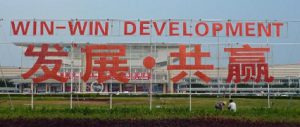Chinese investments in Africa are starting to attract more media coverage and public attention in China. Last year, three incidents in particular sparked interest.
First, in June 2010 the Industrial and Commercial Bank of China (ICBC) agreed to invest US$500 million in Ethiopia’s US$1.75 billion Gibe III dam. The project will affect the Omo River, an international waterway, and the vulnerable ecosystems of Lake Turkana, upon which 300,000 residents of northern Kenya rely.
Then on October 15, supervisors at the Chinese-owned Collum mine in Zambia, southern Africa, shot and wounded at least 11 workers during a dispute – showing that Chinese investment in mining in Africa can create serious labour-relations issues, as well as environmental problems.
Finally, in November China National Offshore Oil Corp (CNOOC) and Ghana National Petroleum Corp joined forces to attempt to buy the US firm Kosmos Energy’s stake in the deepwater Jubilee offshore oil field in Ghana, west Africa. This deal did not go through, but commentators linked it to earlier reports that China would provide the country with US$13 billon in loans for oil and gas infrastructure, agricultural development and other construction.
These three types of projects: fossil fuels, mining and dams, are the main areas of Chinese investment in Africa, and the three cases reflect a number of characteristics and problems around Chinese aid and investment on the continent.
Usually, the difference between aid and investment is that aid is intended to provide humanitarian assistance or promote social and economic progress; unlike investment, there is little concern in aid about recovery of funds. Aid is also preferential – it is provided gratis to the recipient, or at a low rate of interest.
China invests and provides aid in a wide range of fields in Africa. These include: agriculture; healthcare; emergency relief; scholarships, exchanges and training; it also includes voluntary services and the waiving of loans. But although there are differences in emphasis across different African nations, the most funding of all is for the construction of government buildings, dams and other infrastructure.
These are the “full-service aid projects” advocated by the Chinese government, where the project implementer is a Chinese firm and project loans are transferred directly from the Export and Import Bank of China (China EXIM Bank) to that firm rather than to the recipient nation, and equipment required is imported from China. These aid projects play an important role in helping Chinese firms expand overseas.
As for Chinese investment in Africa, fields include: agriculture; forestry; information and communications technology; industry; finance and healthcare. But most investment is concentrated in construction, energy and mining.
Imbalances in aid and investment
China has experimented with linking aid to economic development, both at home and abroad. In the controversial “Angola Model” – as resource-backed financing agreements are referred to by Chinese diplomats – the recipient nation uses its commodities, such as oil resources, to secure low-interest loans for projects.
This means the recipient nation can turn resources into cash when funds are short and develop its extractive industries. It also often secures China’s state-owned oil companies resource-development rights in the recipient nation.
However, it is not enough to focus only on economic development. For the citizens of the recipient nation, justice, participation and sustainability should be part of the planning process right from the start.
On balance it seems that China regards Africa primarily in terms of its resources and potential market – and prioritises those fields over aid, leading to some negative consequences for recipient nations. Prior research on the “resource curse” in countries such as Nigeria suggests that over-reliance on resource development for economic growth can produce some benefits for society, but can also gravely damage the local environment.
China hopes to use this commercial cooperation model to make aid projects more sustainable – but it risks putting Chinese firms in absolute control of projects, with potentially negative effects. Chinese companies may ultimately make the decisions about whether a project goes ahead, influencing policy and allowing the company risk-free entry to the recipient nation.
There is a risk that Chinese companies may apply “high-efficiency” methods overseas that, for example, leave farmers in a weak position – as has been the case in some agricultural investment models in China. The pursuit of profit has also led small private enterprises from China to become involved in illegal trades, in timber or ivory for example, to the detriment of the local environment.
Extending domestic development models
In order to understand the environmental and social impacts of China’s investments in Africa, one should probably understand the impacts of Chinese investment at home in China, since many similar problems arise.
Thirty years of reform and opening up in China has led many – particularly those that have enjoyed the fruits of this process – to believe that economic growth will lead to development in other areas. That belief has been extended to overseas investment. But many others worry about the negative impacts of China’s breakneck growth: the destruction of China’s environment, the pillaging of resources and rising social injustice.
Importantly, within China there are also examples of loans and engineering projects being exchanged for resources contracts. For example, last November it was reported that the local government of Ordos, in Inner Mongolia, had decided manufacturing and high-tech projects of a certain size would be allocated corresponding amounts of coal. This led a number of firms to rush to invest and claim their coal. This type of “resources for investment” deal has been accused of selling off national resources on the cheap, as well as severely damaging the Ordos grasslands.
The Chinese government’s Western Development strategy, first implemented in 2000, led to domestic investors favouring the west of the country, which is rich in resources and contains huge market potential, but is economically backward compared to the east. However, the single-minded focus on developing resources – much like in Africa – has created negative environmental and social consequences.
An essay by Yang Yong, titled “Facing up to the environmental misery of resource development in western China” points out that a series of large and sensitive projects are under construction in China’s west, worsening environmental damage and creating social inequality and conflicts. As development proceeds and capital is invested, the potential to prioritise greener industries or tourism is forgotten in favour of resource development.
Developing a country’s resources, of course, does not necessarily create problems – but if China has been unsuccessful in using policy and regulation to prevent the “resource curse” in its own western region, how can we trust investments in Africa will only have positive results?
Yi Yimin is project officer at Moving Mountains, where she researches the social and environmental impact of economic development in China and overseas. Yi is a member of Friends of Nature.
Homepage image from documentary "When China Met Africa" shows Zambian trade and commerce minister Felix Mutati visiting a Chinese-backed copper smelter.




![India, Uttarakhand, Haridwar, dam on the Ganga [image: Alamy]](https://dialogue.earth/content/uploads/2020/03/P1YATT-300x200.jpg)

